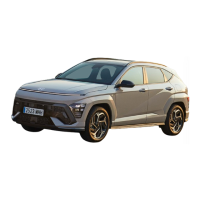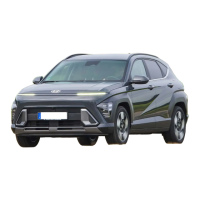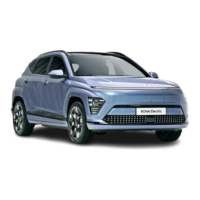Do you have a question about the Hyundai KONA 2021 and is the answer not in the manual?
Introduction to the manual and Hyundai Motor Company.
Guidance on how to effectively navigate and utilize the owner's manual.
Alerts and precautions regarding potential hazards for user safety.
Specifications and recommendations for vehicle fuel types and octane ratings.
Information on modifications and potential warranty implications.
Precautions for the initial 1,000 km of vehicle operation.
Hyundai's policy for end-of-life vehicles in Europe.
Illustration and identification of front exterior features.
Illustration and identification of rear exterior features.
Overview of interior controls for left-hand drive type.
Overview of interior controls for left-hand drive type.
Identification and location of components within the engine bay.
Specifications for vehicle dimensions, wheelbase, and tread.
Technical specifications for various engine types.
Table detailing bulb types and wattages for lighting.
Specifications for tire sizes, inflation pressure, and wheel bolt torque.
Tire load index and speed symbol ratings for European models.
Specifications for refrigerant type and compressor lubricant.
Gross vehicle weight and luggage volume for different configurations.
List of recommended lubricants and their capacities for various systems.
Guidelines for selecting engine oil viscosity based on temperature.
Location and purpose of the Vehicle Identification Number (VIN).
Details on the vehicle certification label on the center pillar.
Information on the tire label for recommended pressures.
Location of the engine number stamped on the engine block.
Information on the compressor label, including model and refrigerant.
Statement confirming compliance with relevant directives for radio frequency components.
Details on gasoline and diesel fuel labels attached to the fuel filler door.
Crucial safety recommendations for operating the vehicle, including seat belts and driver awareness.
Instructions for adjusting front and rear seats, including seatback angle and lumbar support.
Guidelines for proper use, safety precautions, and warnings related to seat belt usage.
Information on selecting, installing, and using child restraint systems for passenger safety.
Explanation of the Supplemental Restraint System (SRS), including air bag locations and operation.
How to adjust instrument panel illumination and interior switch intensity.
Explanation of the speedometer, tachometer, and temperature gauges.
Information on recommended gear shifts for fuel efficiency and performance.
List and explanation of various warning messages displayed on the LCD screen.
Overview of the LCD display and its control buttons for changing modes and settings.
Description of different display modes, including Driving Assist, Trip Computer, and Warning.
Information on using the trip computer for driving data, fuel economy, and speed.
Details on trip computer functionality for Type B clusters, including drive info and accumulated data.
Instructions for locking, unlocking, and operating the tailgate using the remote key or smart key.
Information on operating door locks from inside and outside the vehicle.
Details on the vehicle's anti-theft system, including activation and deactivation.
Information on electric power steering, tilt/telescopic steering, and horn operation.
Instructions for adjusting and operating rearview mirrors, including day/night and power folding.
How to operate power windows, including auto up/down and lock functions.
Instructions for opening, closing, tilting, and resetting the sunroof.
Details on operating the hood, tailgate, and fuel filler door.
Information on operating and adjusting the Head-Up Display, including precautions.
How to operate exterior lights, including lamps and auto light functions.
Pre-drive checks including windows, mirrors, lights, tires, and securing items.
Explanation of key ignition switch positions (LOCK, ACC, ON, START) and their functions.
How to operate the manual transmission, including shift lever movement and clutch usage.
Details on operating the Intelligent Manual Transmission (iMT) system with E-Clutch technology.
Explanation of how the Intelligent Variable Transmission (IVT) operates without fixed gears.
Proper procedures for parking the vehicle, including engaging the parking brake and shift lever positions.
Information on power brakes, disc brake wear indicators, parking brake, and ABS/ESC systems.
How to use the Auto Hold feature to maintain vehicle standstill without brake pedal pressure.
Explanation of how ABS works and precautions for driving in various road conditions.
How the ESC system helps stabilize the vehicle during cornering maneuvers.
Function of Vehicle Stability Management (VSM) in ensuring vehicle stability on challenging roads.
How the Hill-Start Assist Control (HAC) prevents the vehicle from rolling backward on a hill.
How the Emergency Stop Signal (ESS) alerts drivers by blinking stop lights during severe braking.
How the Downhill Brake Control (DBC) supports drivers descending steep hills without brake pedal.
Explanation of the 4WD system, its modes, and precautions for operation.
How the ISG system reduces fuel consumption by automatically stopping and restarting the engine.
How to select and operate drive modes (ECO, NORMAL, SPORT) for optimized performance.
System for optimal driving performance by controlling engine and braking based on road conditions.
Precautions and tips for driving in hazardous conditions like rain, snow, ice, mud, and sand.
Recommendations for minimizing winter driving problems, including snow tires and emergency equipment.
Guidance and legal requirements for towing trailers, including weight limits and safety rules.
Explanation of weight ratings like GVWR, GAWR, and cargo weight for vehicle loading.
Information on Forward Collision-Avoidance Assist (FCA) for front view camera and sensor fusion.
Details on Cruise Control (CC), Smart Cruise Control (SCC), and Navigation-Based Smart Cruise Control (NSCC).
Information on Rear View Monitor (RVM), Rear Cross-Traffic Collision Warning (RCCW), and parking distance warning systems.
Statement confirming compliance with relevant EU directives and regulations.
Function and operation of hazard warning flashers for signaling emergencies.
Steps to take if a tire goes flat, including safe stopping and hazard warning.
Troubleshooting steps for when the engine fails to start or starts slowly.
Procedure and safety precautions for jump starting a vehicle with a dead battery.
Steps to take if the engine overheats, including safety precautions and coolant checks.
Information on the TPMS malfunction indicator and low tire pressure telltale for Type A systems.
Details on checking tire pressure and the TPMS malfunction indicator for Type B systems.
Procedure for changing a tire, including TPMS sensor considerations and torque.
Identification and storage of the jack, jack handle, wheel nut wrench, and towing hook.
Instructions for using the Tire Mobility Kit to temporarily fix a flat tire.
Guidelines and precautions for towing the vehicle, including towing services and equipment.
List of emergency items provided, such as fire extinguisher, first aid kit, and triangle reflector.
Overview of the automatic emergency call service for traffic accidents in Europe.
Identification and location of components within the engine bay.
Overview of maintenance services and owner's responsibility for vehicle upkeep.
Precautions and schedule for owner-performed maintenance tasks.
Recommended maintenance schedule based on normal and severe driving conditions.
Detailed explanation of items covered in the scheduled maintenance schedule.
How to check engine oil level and filter, including specific instructions for gasoline and diesel engines.
Procedures for checking engine coolant level and recommended coolant types.
How to check brake and clutch fluid levels and related precautions.
Checking the iMT system actuator fluid level and handling precautions.
Checking washer fluid level and safety precautions for using washer fluid.
Procedure for checking the parking brake stroke and ensuring it holds the vehicle securely.
Instructions for draining water from the fuel filter and replacing the fuel filter cartridge.
Procedure for inspecting and replacing the air cleaner filter.
Instructions for inspecting and replacing the climate control air filter.
Guidelines for inspecting and replacing windshield and rear window wiper blades.
Introduction to the manual and Hyundai Motor Company.
Guidance on how to effectively navigate and utilize the owner's manual.
Alerts and precautions regarding potential hazards for user safety.
Specifications and recommendations for vehicle fuel types and octane ratings.
Information on modifications and potential warranty implications.
Precautions for the initial 1,000 km of vehicle operation.
Hyundai's policy for end-of-life vehicles in Europe.
Illustration and identification of front exterior features.
Illustration and identification of rear exterior features.
Overview of interior controls for left-hand drive type.
Overview of interior controls for left-hand drive type.
Identification and location of components within the engine bay.
Specifications for vehicle dimensions, wheelbase, and tread.
Technical specifications for various engine types.
Table detailing bulb types and wattages for lighting.
Specifications for tire sizes, inflation pressure, and wheel bolt torque.
Tire load index and speed symbol ratings for European models.
Specifications for refrigerant type and compressor lubricant.
Gross vehicle weight and luggage volume for different configurations.
List of recommended lubricants and their capacities for various systems.
Guidelines for selecting engine oil viscosity based on temperature.
Location and purpose of the Vehicle Identification Number (VIN).
Details on the vehicle certification label on the center pillar.
Information on the tire label for recommended pressures.
Location of the engine number stamped on the engine block.
Information on the compressor label, including model and refrigerant.
Statement confirming compliance with relevant directives for radio frequency components.
Details on gasoline and diesel fuel labels attached to the fuel filler door.
Crucial safety recommendations for operating the vehicle, including seat belts and driver awareness.
Instructions for adjusting front and rear seats, including seatback angle and lumbar support.
Guidelines for proper use, safety precautions, and warnings related to seat belt usage.
Information on selecting, installing, and using child restraint systems for passenger safety.
Explanation of the Supplemental Restraint System (SRS), including air bag locations and operation.
How to adjust instrument panel illumination and interior switch intensity.
Explanation of the speedometer, tachometer, and temperature gauges.
Information on recommended gear shifts for fuel efficiency and performance.
List and explanation of various warning messages displayed on the LCD screen.
Overview of the LCD display and its control buttons for changing modes and settings.
Description of different display modes, including Driving Assist, Trip Computer, and Warning.
Information on using the trip computer for driving data, fuel economy, and speed.
Details on trip computer functionality for Type B clusters, including drive info and accumulated data.
Instructions for locking, unlocking, and operating the tailgate using the remote key or smart key.
Information on operating door locks from inside and outside the vehicle.
Details on the vehicle's anti-theft system, including activation and deactivation.
Information on electric power steering, tilt/telescopic steering, and horn operation.
Instructions for adjusting and operating rearview mirrors, including day/night and power folding.
How to operate power windows, including auto up/down and lock functions.
Instructions for opening, closing, tilting, and resetting the sunroof.
Details on operating the hood, tailgate, and fuel filler door.
Information on operating and adjusting the Head-Up Display, including precautions.
How to operate exterior lights, including lamps and auto light functions.
Pre-drive checks including windows, mirrors, lights, tires, and securing items.
Explanation of key ignition switch positions (LOCK, ACC, ON, START) and their functions.
How to operate the manual transmission, including shift lever movement and clutch usage.
Details on operating the Intelligent Manual Transmission (iMT) system with E-Clutch technology.
Explanation of how the Intelligent Variable Transmission (IVT) operates without fixed gears.
Proper procedures for parking the vehicle, including engaging the parking brake and shift lever positions.
Information on power brakes, disc brake wear indicators, parking brake, and ABS/ESC systems.
How to use the Auto Hold feature to maintain vehicle standstill without brake pedal pressure.
Explanation of how ABS works and precautions for driving in various road conditions.
How the ESC system helps stabilize the vehicle during cornering maneuvers.
Function of Vehicle Stability Management (VSM) in ensuring vehicle stability on challenging roads.
How the Hill-Start Assist Control (HAC) prevents the vehicle from rolling backward on a hill.
How the Emergency Stop Signal (ESS) alerts drivers by blinking stop lights during severe braking.
How the Downhill Brake Control (DBC) supports drivers descending steep hills without brake pedal.
Explanation of the 4WD system, its modes, and precautions for operation.
How the ISG system reduces fuel consumption by automatically stopping and restarting the engine.
How to select and operate drive modes (ECO, NORMAL, SPORT) for optimized performance.
System for optimal driving performance by controlling engine and braking based on road conditions.
Precautions and tips for driving in hazardous conditions like rain, snow, ice, mud, and sand.
Recommendations for minimizing winter driving problems, including snow tires and emergency equipment.
Guidance and legal requirements for towing trailers, including weight limits and safety rules.
Explanation of weight ratings like GVWR, GAWR, and cargo weight for vehicle loading.
Information on Forward Collision-Avoidance Assist (FCA) for front view camera and sensor fusion.
Details on Cruise Control (CC), Smart Cruise Control (SCC), and Navigation-Based Smart Cruise Control (NSCC).
Information on Rear View Monitor (RVM), Rear Cross-Traffic Collision Warning (RCCW), and parking distance warning systems.
Statement confirming compliance with relevant EU directives and regulations.
Function and operation of hazard warning flashers for signaling emergencies.
Steps to take if a tire goes flat, including safe stopping and hazard warning.
Troubleshooting steps for when the engine fails to start or starts slowly.
Procedure and safety precautions for jump starting a vehicle with a dead battery.
Steps to take if the engine overheats, including safety precautions and coolant checks.
Information on the TPMS malfunction indicator and low tire pressure telltale for Type A systems.
Details on checking tire pressure and the TPMS malfunction indicator for Type B systems.
Procedure for changing a tire, including TPMS sensor considerations and torque.
Identification and storage of the jack, jack handle, wheel nut wrench, and towing hook.
Instructions for using the Tire Mobility Kit to temporarily fix a flat tire.
Guidelines and precautions for towing the vehicle, including towing services and equipment.
List of emergency items provided, such as fire extinguisher, first aid kit, and triangle reflector.
Overview of the automatic emergency call service for traffic accidents in Europe.
Identification and location of components within the engine bay.
Overview of maintenance services and owner's responsibility for vehicle upkeep.
Precautions and schedule for owner-performed maintenance tasks.
Recommended maintenance schedule based on normal and severe driving conditions.
Detailed explanation of items covered in the scheduled maintenance schedule.
How to check engine oil level and filter, including specific instructions for gasoline and diesel engines.
Procedures for checking engine coolant level and recommended coolant types.
How to check brake and clutch fluid levels and related precautions.
Checking the iMT system actuator fluid level and handling precautions.
Checking washer fluid level and safety precautions for using washer fluid.
Procedure for checking the parking brake stroke and ensuring it holds the vehicle securely.
Instructions for draining water from the fuel filter and replacing the fuel filter cartridge.
Procedure for inspecting and replacing the air cleaner filter.
Instructions for inspecting and replacing the climate control air filter.
Guidelines for inspecting and replacing windshield and rear window wiper blades.
| Brand | Hyundai |
|---|---|
| Model | KONA 2021 |
| Category | Automobile |
| Language | English |












